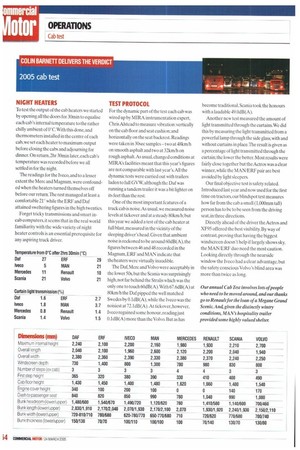111 1 1C1:11 1 :U1411 1 1:11 7 1;ibililaMPILPII
Page 54

If you've noticed an error in this article please click here to report it so we can fix it.
2005 cab test
NIGHT HEATERS To test the output of the cab heaters we started by opening all the doors for 30min to equalise each cab's internal temperature to the rather chilly ambient of 0°C. With this done, and thermometers installed in the centre of each cab, we set each heater to maximum output before closing the cabs and adjourning for dinner. On return,2hr 30min later, each cab's temperature was recorded before we all settled in for the night.
The readings for the Iveco, and to a lesser extent the Merc and Magnum, were confounded when the heaters turned themselves off before our return.The rest managed at least a comfortable 21° while the ERF and Daf attained sweltering figures in the high twenties.
Forget tricky transmissions and smart incab computers. it seems that in the real world familiarity with the wide variety of night heater controls is an essential prerequisite for any aspiring truck driver. TEST PROTOCOL For the dynamic part of the test each cab was wired up by MIRA instrumentation expert, Chris Alstead to measure vibration: vertically on the cab floor and seat cushion; and horizontally on the seat backrest. Readings were taken in 30sec samplestwo at 48km/h on smooth asphalt and two at 32krn/h on rough asphalt. As usual, changed conditions at MIRA's facilities meant that this year's figures are not comparable with last year's. All the dynamic tests were carried out with trailers laden to full GVW, although the Daf was running a tandem trailer it was a bit lighter on its feet than the rest.
One of the most important features of a truck cab is noise. As usual, we measured noise levels at tickover and at a steady 80km/h; but this year we added a test of the cab heater at full blast.measured in the vicinity of the sleeping driver's head, Given that ambient noise is reckoned to be around 60dB(A),the figures between 46 and 48 recorded in the Magnum,ERF and MAN indicate that theheaters were virtually inaudible.
The Daf, Mere and Volvo were acceptably in the lower 50s, but the Scania was surprisingly high,not far behind the Stralis which was the only one to touch 60dB(A).With 67.6dB(A) at 80km/h the Daf pipped the well matched Swedes by 0.1dB(A), while the Iveco was the noisiest at 72.1dB (A). At tickover, however, New regained some honour, reading just 0.1dB(A) more than the Volvo. But as has become traditional. Scania took the honours with a laudable 49.0dB(A).
Another new test measured the amount of light transmitted through the curtains. We did this by measuring the light transmitted from a powerful lamp through the side glass, with and without curtains in place. The result is given as a percentage of light transmitted through the curtain; the lower the better. Most results were fairly close together but the Actros was a clear winner, while the MAN/ERF pair are best avoided by light sleepers.
Our final objective test is safety related. Introduced last year and now used for the first time on tractors, our blindspot test measures how far from the cab a small (1,000mm tall) person has to be to be seen from the driving seat, in three directions.
Directly ahead of the driver the Actros and XF95 offered the best visibility. By way of contrast, proving that having the biggest windscreen doesn't help if largely shows sky, the MAN/ERF duo need the most caution. Looking directly through the nearside window the lveco had a clear advantage, but the safety conscious Volvo's blind area was more than twice as long.










































































































































































































